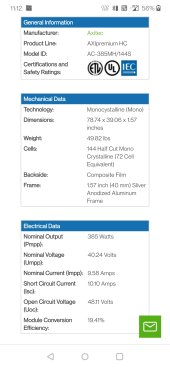Watch Me Build
New Member
- Joined
- Jul 4, 2020
- Messages
- 98
 here's the specs on the panel. Trying to do s2p6 into the combiner box. So 12 panels total.
here's the specs on the panel. Trying to do s2p6 into the combiner box. So 12 panels total.The run from the combiner box to the PIP 3048LV-MK is 30 ft. Can I get away with 6awg wire? And what's the most cost effective wire I can go with when running through underground conduit?
Also what gauge wire from the panels to the combiner box?


